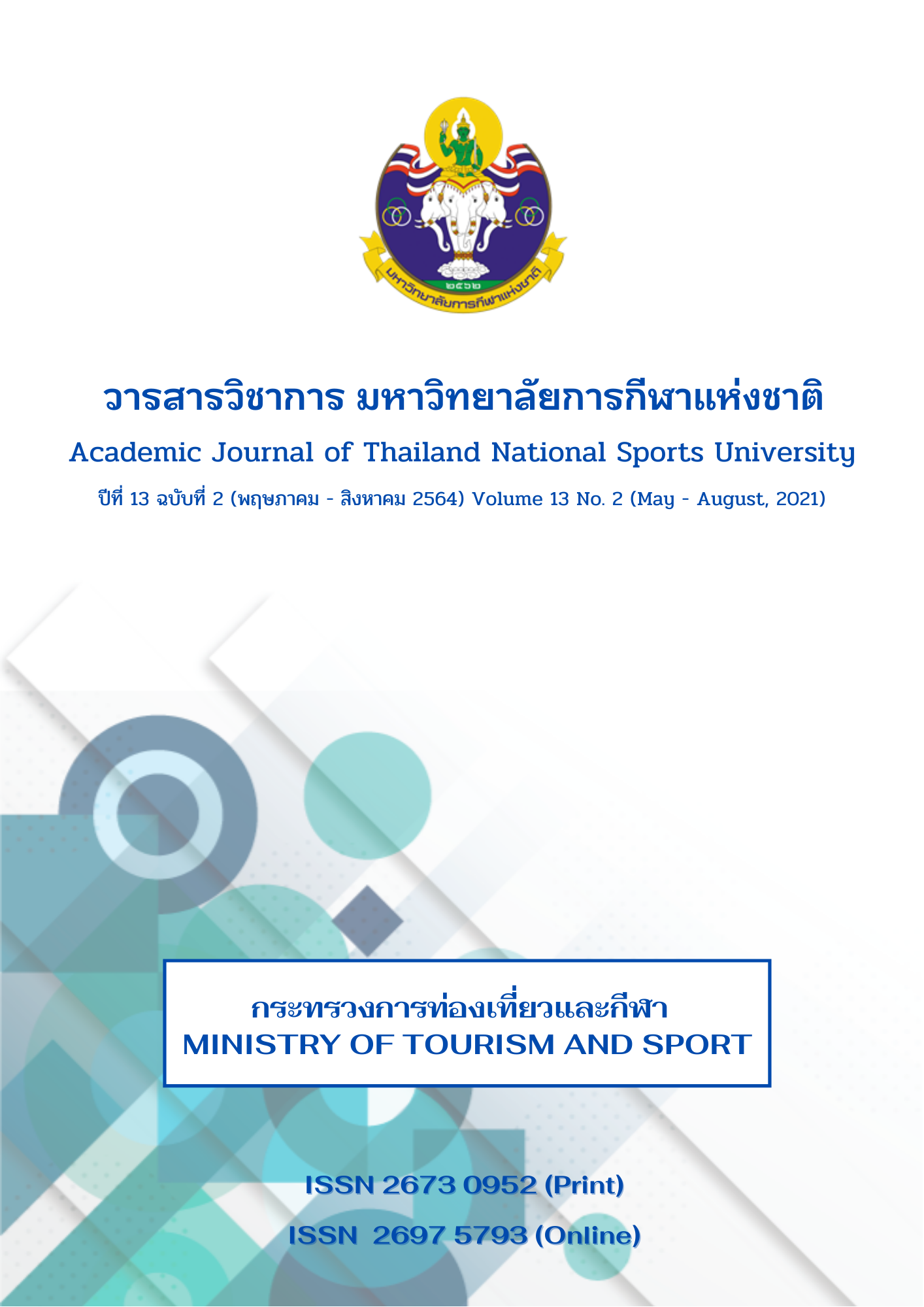EFFECTS OF BACKWARD WALKING EXERCISE ON BODY COMPOSITION AND MAXIMAL OXYGEN UPTAKE IN OVERWEIGHT ADOLESCENTS
Main Article Content
Abstract
The purpose of this study was to study the effects of backward walking exercise on body composition and maximal oxygen uptake in overweight adolescents. Samples were 20 male students who enrolled course of Exercise Science for Health, aged 18-22 years, with body mass index (BMI) 23.00-27.40 kg/m2. They were equally divided into 2 groups by simple random sampling, the control (CON) group (did regular daily life) and the backward (BW) group. Subjects in the BW group walked backward at selected speed, 4.3, 5.0, and 5.8 km/hr at 1st, 2nd, and 3rd - 4th week, respectively. They underwent exercise program 5 times a week for 4 weeks. The variables were collected before and after training. The outcomes were analyzed using t-test at statistically significant differences at .05 level. The results showed that after 4 week of training, body composition and maximal oxygen uptake in BW group were significantly improve at .05 level. Furthermore, flexibility, leg muscular endurance and strength of the BW group were greater than the CON group at .05 level. In conclusion, backward walking exercise can improve body composition and maximal oxygen uptake including flexibility, leg muscular endurance and strength in overweight adolescents. This improvement may be related to backward locomotion which elicit a given energy expenditures and need more motor unit recruitment of leg muscle. The physiological variables were then response and improve on body composition and maximal oxygen uptake.
Article Details
The published article is a copyright of the Academic Journal of Thailand National Sports University. The passage appeared in each article in this academic journal is a perspective of each author which is not related to the journal. Each author is required to be responsible for all components of his/her own article. If there are any mistakes, each author must be responsible for those mistakes on his/her own.
References
Areerat Suputtitada, Mana Sriyudthsak, & Sompol Sanguanrungsirikul. (2009). Gait ability improvement and fall prevention in elderly and Parkinson's disease. Research program, Bangkok: Chulalongkorn University.
Aroonrasamee Bunnag, Parnnarat Sangperm, Weeraya Jungsomjatepaisal, Yuwadee Pongsaranunthakul, & Venus Leelahakul. (2012). The effects of behavioral modification for eating and exercising behavior in overweight adolescents. J Nurse Sci, 30(4), 37-48.
Cha, H.G., Kim, T.H., & Kim, M.K. (2016). Therapeutic efficacy of walking backward and forward on a slope in normal adults. J. Phys. Ther. Sci, 28, 1901-1903.
Charoen Krabuanrat. (1995). Technique of speed training. Bangkok: Faculty of Education, Kasetsart University.
Childs, J.D., Gantt, C., Higgins, D., Papazis, J.A., Franklin, R., Metzler, T., & Underwood, F.B. (2002). The effect of repeated bouts of backward walking on physiologic efficiency. Journal of Strength and Conditioning Research, 16(3), 451-455.
Chusak Vechaphaet & Kanya Palawiwat. (1993). Exercise physiology. Bangkok: Thankamon Press.
Chuthipath Chewwasung, Rumpa Boonsisukh, Sasithorn Bannarat, Kanjana Thumpapong, & Pawaree Meesukh. (2010). Comparison of Vastus medialis, Semitendinosus, Tibialis anterior, Peroneous longus and Gastrocnemius muscle activities between forward and backward walking. Thai Journal of Physical Therapy, 33(1), 10-16.
Dangi, A., & Nirbhavane, U. (2014). Comparison of forward walking versus backward walking on level surface on body composition in pre obese individuals in the group of 20-40 years. International Journal of Scientific and Research Publications, 4(4), 1-5.
Hooper, T.L., Dunn, D.M., Props, J.E., Bruce, B.A., Sawyer, S.F., & Daniel, J.A. (2004). The effects of graded forwarded and backward walking on heart rate and oxygen consumption. Journal of Orthopaedic & Sports Physical Therapy, 34(2), 65-71.
Kanlayanee No-in. (2017). Overweight and obesity among Thai school-aged children and adolescents. Journal of the Royal Thai Army Nurses, 18, 1-8.
Kesinee Saelao, & Vijit Kanungsukkasem. (2012). Effects of arm swing exercise, walking and walking exercise combined with arm swing exercise on health-related physical fitness of the elderly women. Journal of Sports Science and Health, 13(1). 92-103.
McArdle, W.D. Katch, F.I., & Katch, V.L. (2000). Essentials of exercise physiology (2nd ed.). Philadelphia: Lippincott Williams and Wilkins.
Myatt, G., Baxter, R., Dougherty, R., Williams, G., Halle, J., Stetts, D., & Underwood, F. (1995). The cardiopulmonary cost of backward walking at selected speeds. Journal of Orthopaedic & Sports Physical Therapy, 21(3), 132-138.
Research and Development Section, Bureau of Sport Science, Office of Sport and Recreation Development. (2009). Analysis of forward and backward walking for exercise. Bangkok.
Santisith Khiewkhern, & Phongpan Teerawattanasak. (2017). Factors related to over-waist circumference and overweight among nurses in Phichit hospital. Journal of Health Science, 26(1), S147-S155.
Sasipa Jinajin, & Thanomwong Kritpet. (2008). Effect of walking on health-related physical fitness in overweight working group. Journal of Sports Science and Health, 9(2), 1-15.
Supitr Samahito, Vullee Bhatharobhas, Siriporn Sasimontonkul, Amphorn Sriyabhaya, Nanthawan Thienkaew, Pailin Puagprakong, & Sarayut Noikasem. (2013). Test and norms of physical fitness for people ages 19-59 years. Department of Physical Education, Ministry of Tourism and Sports.
Tanusint Sriwilai, Araya Yankai, & Sulibhorn Cheewapanich. (2007). Energy expenditure index of backward walking in normal individuals aged 19-22 years. Bull Chiang Mai Assoc Med, 40(3), 236-242.
Teerawan Sutham, & Napatsawan Thanaphonganan. (2016). Effects of aerobic exercise to the health-related physical fitness on overweight. Academic Services Journal, Prince of Songkla University, 27(3), 73-88.
Thanomwong Kritpet, & Sitha Pongphibool. (2011). Exercise physiology. Bangkok: Trironasarn.
Terblanche, E., Page, C., Kroff, J., & Venter, R.E. (2005). The effect of backward locomotion training on the body composition and cardiorespiratory fitness of young women. Int Sports Med, 26, 214-219.
WHO Expert consultation. (2004). Appropriate body-mass index for Asian populations and its implications for policy and intervention strategies. The Lancet, 363, 157-163.


